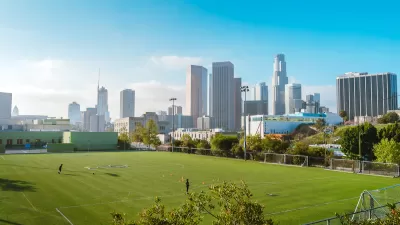Los Angeles County's Community Parks and Recreation Plans (CPRPs) are an evolved methodology to process a broad range of data to better site and design community parks. CPRPs are explained by L.A. County park planner Clement Lau
Community Parks and Recreation Plans (CPRPs) represent Los Angeles County's latest approach for community-based park and recreation planning, writes L.A. County park planner Clement Lau. CPRPs should better plan parks in underserved communities in particular. They go beyond traditional park master plans by analyzing and addressing the park and greening needs of unincorporated communities in a comprehensive way that extends outside of the boundaries of existing parks. In particular, the CPRPs not only seek to improve existing parks, but they provide a roadmap to create new green spaces in non-traditional locations, make specific recommendations to increase the urban forestry, and advance local and regional sustainability goals. Also, the CPRPs are the products of extensive public outreach processes that not only included traditional public meetings, but involved partnerships with local community-based organizations and the application of various community engagement strategies, such as focus groups, stakeholder interviews, surveys, and tabling at community events.
Goals and criteria of CPRPs include:
- Address climate change through Greenhouse Gas (GHG) emission reduction or adaptation planning
- Preserve and enhance recreational areas
- Promote energy and/or water efficiency and savings
- Ensure environmental justice regardless of race, ethnicity, or income class
- Promote overall sustainability on various resources issues
- Better placemaking
- Lower cost to taxpayers & families
- Benefits to public health & the environment
- Greater responsiveness to demographics & changing housing market
- Improved access & mobility
FULL STORY: Park Planning for Underserved Communities in Los Angeles County

Planetizen Federal Action Tracker
A weekly monitor of how Trump’s orders and actions are impacting planners and planning in America.

San Francisco's School District Spent $105M To Build Affordable Housing for Teachers — And That's Just the Beginning
SFUSD joins a growing list of school districts using their land holdings to address housing affordability challenges faced by their own employees.

The Tiny, Adorable $7,000 Car Turning Japan Onto EVs
The single seat Mibot charges from a regular plug as quickly as an iPad, and is about half the price of an average EV.

Seattle's Plan for Adopting Driverless Cars
Equity, safety, accessibility and affordability are front of mind as the city prepares for robotaxis and other autonomous vehicles.

As Trump Phases Out FEMA, Is It Time to Flee the Floodplains?
With less federal funding available for disaster relief efforts, the need to relocate at-risk communities is more urgent than ever.

With Protected Lanes, 460% More People Commute by Bike
For those needing more ammo, more data proving what we already knew is here.
Urban Design for Planners 1: Software Tools
This six-course series explores essential urban design concepts using open source software and equips planners with the tools they need to participate fully in the urban design process.
Planning for Universal Design
Learn the tools for implementing Universal Design in planning regulations.
Smith Gee Studio
City of Charlotte
City of Camden Redevelopment Agency
City of Astoria
Transportation Research & Education Center (TREC) at Portland State University
US High Speed Rail Association
City of Camden Redevelopment Agency
Municipality of Princeton (NJ)





























